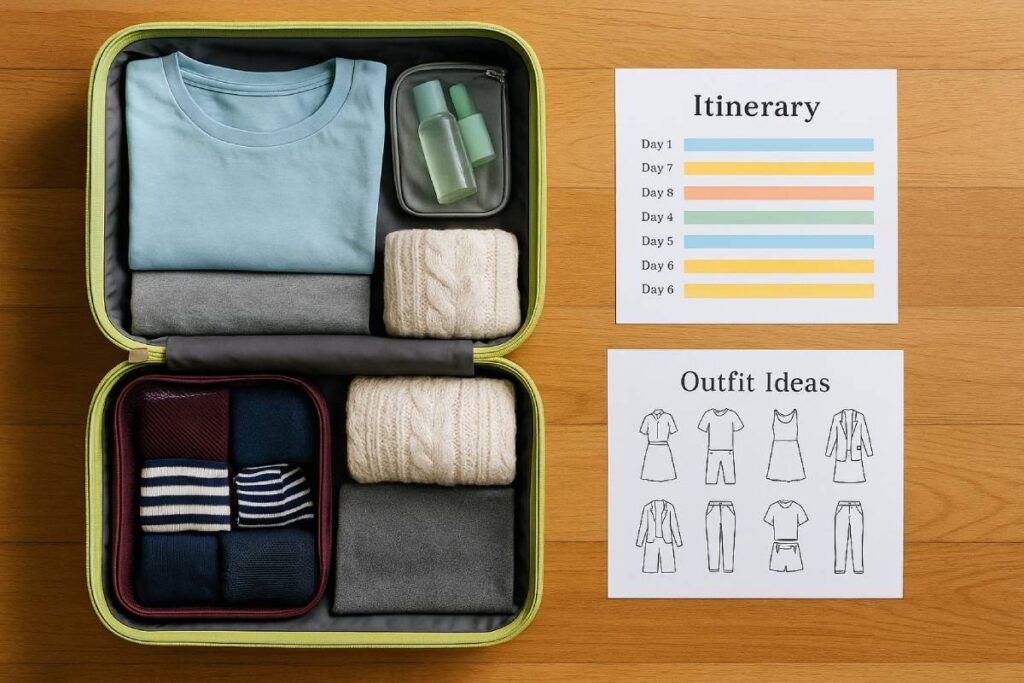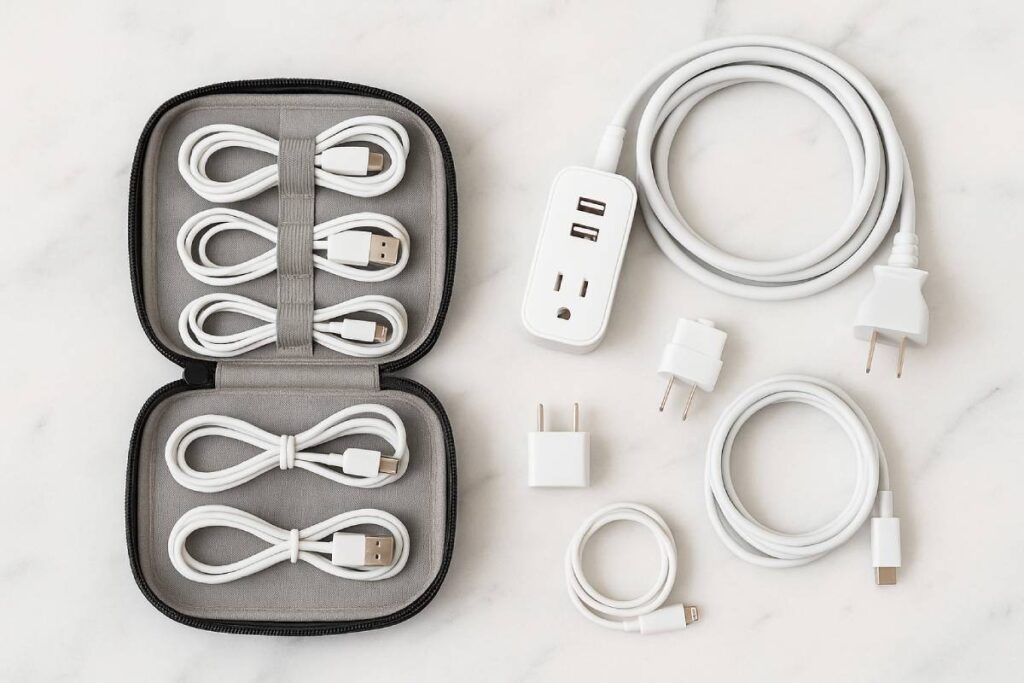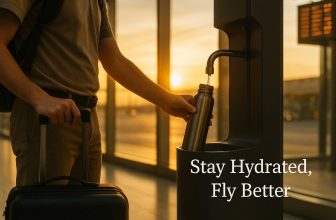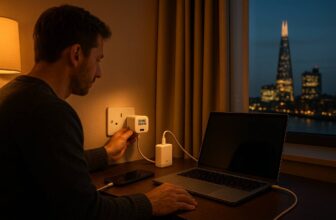Ready to pack like a pro? Flight attendants live out of carry-ons, mastering space, weight, and wrinkle control on every trip.
From swapping bulky suitcases for bright, flexible fabric rollers to mapping outfits by itinerary, they hack every inch of luggage for peak efficiency.
Packing cubes become your wardrobe’s personal assistants, while compression bags crush jackets down by up to 30% of their volume.
Stash an AirTag for live-tracking, nest fragile items in cozy clothing layers, and top it all off with a TSA-compliant 3-1-1 liquids bag at the ready.
Follow these flight-attendant-approved tactics and transform your next journey’s packing routine—stress-free and style-savvy.
Pre-Packing Preparation

Before you even unzip your suitcase, setting the stage with the right gear and a clear plan can shave hours off packing stress and prevent costly last-minute buying or overweight fees. Flight attendants—experts at living out of a bag—strongly recommend soft-shell, fabric suitcases over rigid models for unmatched durability under cargo-hold pressure.
Choosing a bright-colored case not only makes spotting your luggage painless but also deters mix-ups. Equally crucial is selecting a two-wheel design: larger, fixed wheels glide over uneven terrain without jamming and put less strain on your arm and wrist. Once you’ve nailed your luggage choice, mapping outfits to your itinerary—from sightseeing days to evening dinners—ensures every garment earns its spot, drastically reducing overpacking.
Harnessing versatile key pieces and smart packing tools like the Stylebook app will boost your wardrobe options without bulking up your bag.
Choose the Right Luggage
Start with a fabric suitcase rather than a hard-shell model—flight attendant Emilie Cooke-Martageix advises that soft-shell cases flex under pressure and resist cracks in the cargo hold, while rigid shells can shatter when crushed by other bags. Opt for a bright hue (besides white, which soils easily) to make your bag pop on the carousel and avoid the “look-alike” scramble.
Favor a two-wheel roller over a spinner: larger wheels on an upright design roll straight more reliably, navigate debris effortlessly, and spare your joints from awkward twisting. Look for cases crafted from hi-count EVA-molded polyester with PVC backing—materials tested in heavy-duty luggage like the Rockland Softside upright set, proven to withstand repeated abrasion and expansion stresses.
Finally, check for weather-resistant coatings or extended warranties (as with top-rated picks in Forbes’s Best Luggage 2025 guide) to protect against rain, scratches, and wear between trips.
Create an Itinerary-Based Packing Plan
Rather than tossing in “just in case” items, plan outfits around each day’s activities. Real Simple’s pros recommend laying out looks based on your schedule—whether it’s museum visits or beachside cocktails—to limit yourself to essentials only.
Anchor your wardrobe on versatile key pieces (e.g., a neutral blazer or convertible day-to-night dress) and mix in statement accessories or scarves, which maximize outfit permutations without extra bulk.
Embrace a neutral palette for foundational garments, then layer color or texture to refresh the look, as stylist Tan France advises for streamlined, stylish packing. Roll lighter layers and compress bulky knits—these methods fill gaps and preserve fabric integrity. To take it further, use tools like the Stylebook app to visualize your ensembles in advance, ensuring each item coordinates across multiple days and you never pack a “stray” piece.
By combining a thoughtfully selected, sturdy suitcase with an itinerary-aligned packing plan, you’ll breeze through your next trip feeling organized, light, and completely in control of your travel wardrobe.
Essential Tools and Accessories
Flight attendants never leave home without a few packing essentials that make wardrobe management and luggage security effortless. Packing cubes come in multiple sizes—small for undergarments, medium for tops, large for pants—and help you quickly locate uniforms, casual outfits, and dirty laundry without digging through your entire bag.
Compression bags use dual-zipper technology to squeeze out air, freeing up to 60% more volume for bulky coats and sweaters. And slipping a luggage tracker like an AirTag inside your case provides live location updates—airlines such as Delta and United now even let you share that info directly with customer service to expedite lost-luggage recovery.
Packing Cubes
Flight crews swear by using a variety of cube sizes to keep different categories separate—undergarments in small cubes, shirts in medium, and pants in large—so you can pull out only what you need.
Islands.com notes that having at least three cube sizes can reduce the time you spend searching by up to 30%, since each cube’s contents are predetermined and labeled. Assigning one cube solely for dirty laundry prevents cross-contamination with clean uniforms, making post-trip sorting and washing a breeze.
Compression Bags
When space is at a premium, compression bags become indispensable. These bags can reduce garment volume by up to 60%, according to real-world tests by packing experts. Industry data shows the global compression-bag market was valued at USD 1.2 billion in 2024, underscoring their explosive popularity among travelers and home organizers alike.
Leading brands like Eagle Creek’s Pack-It Specter use a zipper-on-zipper system, which not only compresses bulky layers but also offers moisture and odor protection for long-haul trips.
Luggage Trackers
Compact trackers such as Apple AirTag and Tile Pro slip into inner pockets and link to vast crowdsourced networks for near real-time location updates. With iOS 18.2, Apple added the ability to share your AirTag’s location with major airlines—United, American, Delta, JetBlue, and British Airways—so agents can pinpoint your missing bag faster than ever.
Android-friendly options like the Samsung Galaxy SmartTag2 and Eufy SmartTrack Link offer similar accuracy and now support features like SOS alerts through Life360.
Luggage Tracker Comparison
| Tracker Model | Network / App | Key Feature | Price Range |
|---|---|---|---|
| Apple AirTag | Find My | UWB precision; airline integration | $29 |
| Eufy SmartTrack Link | Tile / Amazon Sidewalk | Rechargeable; SOS alerts | $20–36 |
| Samsung Galaxy SmartTag2 | Galaxy Find | Durable; ideal for Samsung devices | $22–30 |
By equipping your suitcase with these essential tools and accessories, you’ll pack smarter, travel lighter, and stay in control—even when you’re hopping between time zones.
Clothing Organization Techniques
Before diving into specific techniques, it’s important to recognize that how you fold or bundle your clothes—and what pieces you choose in the first place—can make or break both space efficiency and wrinkle control.
Research shows that rolling garments can free up to 30% more volume compared to traditional folding, while strategic bundle-wrapping and flat packing in protective sleeves preserve delicate fabrics. Complementing these methods with a capsule wardrobe mindset—selecting multi-use, neutral pieces—ensures every item you pack earns its keep, drastically cutting down bulk without sacrificing style.
Roll vs. Fold
Travel + Leisure’s testing confirms that rolling clothes tightly into compact cylinders avoids the sharp creases that cause deep wrinkles and can save up to 30% of your suitcase volume compared to flat folding.
The Ranger Rolling method—folding the bottom two inches inside out to create a pocket, then rolling snugly and tucking in the excess—locks your roll in place so it won’t unravel in transit. For delicate fabrics, loosely rolling and placing items near the top of your bag reduces pressure, and wrapping each roll in tissue or dry-cleaning sleeves adds an extra anti-wrinkle layer.
For structured pieces like blazers or dresses, Condé Nast Traveler recommends flat packing inside plastic dry-cleaning bags: this “dry sleeve” method preserves the garment’s shape and minimizes fold lines during handling.
And when you need to keep multiple delicate items in pristine condition without individual handling, the bundle-wrapping technique—wrapping garments around a small core—creates a protective outer layer for the most wrinkle-prone pieces. Just note that accessing a single item requires unfurling the entire bundle, which is why frequent-access items are better rolled or folded separately.
Roll vs. Fold Comparison
| Method | Pros | Cons | Best For |
|---|---|---|---|
| Rolling | Saves up to 30% space; minimizes deep creases | Less ideal for very structured garments; rolls may loosen if not secured | T-shirts, jeans, casual wear |
| Bundle-Wrapping | Core-based protection keeps delicate items smooth | Preserves the shape of suits/blazers; dry-cleaning bags prevent wrinkles | The entire bundle must be unpacked for access |
| Flat Packing | Preserves shape of suits/blazers; dry-cleaning bags prevent wrinkles | Takes more space; garments may shift without additional support | Structured or formal wear |
Capsule Wardrobe Mindset
To complement smart folding, embrace a capsule wardrobe approach: select a limited palette of neutral, multi-functional garments that can be mixed and matched for every day of your trip.
Real Simple advises following the “rule of threes”—one pair of pants, one skirt, and one dress—so each base piece works with multiple tops or accessories, dramatically reducing the total number of items you need to pack.
By anchoring your travel wardrobe on versatile staples—think a neutral blazer, a simple white tee, and dark denim—you unlock dozens of outfit combinations without extra bulk. Further, planning your capsule around destination-appropriate layers (e.g., lightweight linen for beach trips or a tailored coat for city breaks) means every piece serves multiple styling needs, preventing overpacking and ensuring you look put-together no matter where you go.
Combining these clothing organization techniques—rolling, bundle-wrapping, flat packing, and a capsule wardrobe selection—will help you pack lighter, stay organized, and arrive wrinkle-free and ready to explore.
Strategic Placement of Items
Proper strategic placement of items in your suitcase drastically improves stability, protects delicate goods, and streamlines security checks. Positioning heavy items like shoes and toiletry kits at the bottom near the wheels lowers the center of gravity, reducing strain on handles and preventing tipping during transit.
Nesting fragile items—glassware, electronics, or souvenirs—in the suitcase’s middle, cushioned by layers of soft clothing, provides natural shock absorption and minimizes breakage. Stowing all liquids, gels, and aerosols in a single, clear, quart-sized TSA-compliant bag at the top of your bag ensures quick, hassle-free removal for screening and full compliance with the 3-1-1 rule.
Heavy Items at the Bottom
Begin by positioning your heaviest items—shoes, toiletry kits, and bulky electronics—directly above the suitcase wheels to create a stable base. This anchors the bottom of your bag, preventing lighter garments from crushing or shifting under weight.
This deliberate weight distribution lowers the center of gravity, reducing handle torque and preventing the suitcase from tipping when you roll it through crowded terminals or over uneven surfaces. It also frees up upper compartments for lighter, more delicate items, keeping everything organized and balanced.
Fragile Items in the Middle
Ideal placement for fragile items such as glassware, camera gear, or souvenirs is the middle of the suitcase, sandwiched between soft layers of clothing for natural shock absorption. Avoid loose packing; instead, nest breakables in a “cushion pocket” carved from rolled T-shirts or sweaters.
Many experienced travelers also recommend wrapping individual items in soft socks or dry-cleaning sleeves, then securing them in this clothing nest. If you have hardside compartments or padded travel pouches, place electronics and lotions there for an extra layer of protection.
Liquids and Toiletries Management
All liquids, gels, and aerosols must be in containers no larger than 3.4 ounces (100 milliliters) and fit within a single quart-sized, clear, resealable plastic bag, according to TSA regulations.
To streamline the security screening process, place this bag at the very top of your suitcase or in an exterior compartment so you can pull it out without unpacking the rest of your belongings. Make sure the bag fully seals to prevent leaks and keep your other items dry.
Quick-Reference: TSA 3-1-1 Liquids Rule
| Component | Requirement |
|---|---|
| Container Size | ≤ 3.4 ounces (100 milliliters) per item |
| Bag Type | Clear, quart-sized (approx. 1 L), resealable |
| Bag Limit | 1 per passenger |
| Placement | Top compartment for easy removal and inspection |
Data source: TSA.gov
Maximizing Carry-On Space
Wearing your bulkiest items onboard—like heavy jackets and boots—can instantly free up precious carry-on volume, helping you dodge overweight fees and streamline security checks.
Pairing that with a well-organized personal item—think totes or backpacks with dedicated sleeves and pockets for electronics, documents, and snacks—keeps everything within arm’s reach and prevents last-minute rifling through your bag. Together, these simple shifts can transform your carry-on strategy, letting you travel lighter, smarter, and more comfortably.
Wear Bulkiest Items
Travel experts universally recommend wearing your heaviest shoes and jacket on the plane rather than packing them. Not only does this save space in your carry-on, but it also keeps you warm during potentially chilly cabin rides.
Business Insider notes that donning bulky items in transit can reduce your bag’s weight and volume, letting you fit more essentials without upgrading to checked luggage. Layering strategically—such as wearing a sturdy pair of boots under a lightweight outfit—ensures you stay comfortable while keeping your suitcase slim and manageable.
Personal Item Hacks
Your personal item should serve as a mobile organizer, not just a spare bag. Opt for a tote or backpack with built-in compartments—laptop sleeves, zip-close pouches, and quick-access pockets:
- Briggs & Riley Essential Tote: Lightweight yet roomy, with sections for travel documents, a padded laptop sleeve, and a zippered pouch for chargers and cables.
- MZ Wallace Medium Metro Tote Deluxe: Features exterior pockets, a luggage-sleeve hook, and a removable crossbody pouch—ideal for stashing on-the-go necessities.
- Baggu Cloud Carry-on: Made from durable nylon, with a removable pouch inside, padded straps, and external pockets for easy access to your phone or water bottle.
- Everki Atlas 17″ Wheeled Laptop Backpack: Built-in cable organizers and reinforced pockets protect electronics and maintain order.
- LATAM Airlines Recommendation: Stow passports, jewelry, and expensive gadgets in your personal item to ensure they’re never out of sight, especially when gate-checked.
Comparison of Top Personal Item Bags
| Bag | Key Compartments | Underseat Fit | Price Range | Reviews |
|---|---|---|---|---|
| Briggs & Riley Essential Tote | Main compartment, padded laptop sleeve, zip pockets | Yes | $200 | 4.5/5 |
| MZ Wallace Medium Metro Tote Deluxe | Exterior pockets, luggage sleeve, charger pouch | Yes | $275 | 4.7/5 |
| Baggu Cloud Carry-on | Removable pouch, padded straps, external pocket | Yes | $50 | 4.8/5 |
By wearing bulky layers and upgrading your personal item into a compartmentalized powerhouse, you’ll reclaim cubic inches in your carry-on, move through security with ease, and always know exactly where your essentials are—no frantic rummaging required.
Tech and Electronics
Organizing your tech gear thoughtfully keeps cables tangle-free and gadgets protected, shaving minutes off setup time and preserving your devices’ lifespan. Below are flight-attendant-approved methods and recommended products to streamline your travel tech kit.

Cable Organizers
Whether you’re juggling chargers, earbuds, or adapters, a dedicated tech pouch keeps everything in its place.
- Compact Loops & Pockets
The best organizers feature elastic loops, slip-in pockets, and zip compartments to separate USB cables, power bricks, and small accessories, preventing frustrating tangles. - Stand-Up Access
The Aer Cable Kit 2 X-Pac is lined in bright orange for visibility, stands upright on its own, and offers multiple compartments for neat storage. - Multi-Functional Converter Pouches
Reddit users praise the Mogics Power Bagel for combining a universal converter with a built-in cable manager—perfect for international travel. - Specialized Magnetic Keepers
TechAdvisor names Anker’s multipurpose cord keeper the top magnetic organizer, ideal for quickly clipping and unclipping cables without fuss. - Durable Materials
Look for water-resistant nylon or hardshell exteriors to guard against impacts and moisture; many premium organizers use reinforced zippers and padded lining for extra protection.
Comparison: Top Cable Organizers
| Organizer Model | Type | Key Features | Price Range |
|---|---|---|---|
| Aer Cable Kit 2 X-Pac | Soft-shell pouch | Bright lining, upright stand, multi-compartments | $55 |
| Bagsmart Electronics Case | Zip-up fabric case | Elastic loops, mesh pockets, water-resistant | $20 |
| Anker Cord Keeper | Magnetic clip set | Quick-attach magnets, compact carry | $15 |
Extension Cords and Adapters
Maximize outlet access and minimize adapter clutter with these savvy power solutions.
- Pack a Lightweight Extension Cord
A simple extension cord doubles your reach and adds extra sockets for bedside charging or cramped airport lounges, yet it weighs under 6 ounces and coils tightly for easy stashing. - Include a Compact Power Strip
LifeProTips recommends slipping a small power strip into your luggage so you only need one universal adapter to power multiple devices at once. - Ultra-Portable Power Strips
The BEVA Travel Power Strip measures just 3.9×2.1×1.7 inches, offers two AC outlets plus USB-A and USB-C ports, and weighs only 8.46 ounces—ideal for hotel rooms. - Swivel & Surge-Protected Models
Toomanyadapters.com highlights the Belkin SurgePlus Swivel Charger as a mini-power strip that fits in your pocket, with 3 AC outlets and 2 USB ports for versatile charging.
Comparison: Travel Power Strips
| Power Strip Model | AC Outlets | USB Ports | Cable Length | Key Feature | Price |
|---|---|---|---|---|---|
| BEVA Travel Power Strip | 2 | 1×USB-C, 2×USB-A | 4 ft | Flat plug, silicone strap for cord wrap | $25 |
| Belkin SurgePlus Swivel Charger | 3 | 2×USB-A | N/A | Swiveling plug, surge protection | $20 |
| Basic Extension Cord (LifeProTip) | 3+ | 0 | 6 ft | Lightweight, extra reach | $8 |
By incorporating a dedicated cable organizer and a compact power solution into your kit, you’ll eliminate tech chaos, protect your gear, and always have power at your fingertips—no matter where you roam.
Security and Accessibility
Mastering security and accessibility starts with strict adherence to the TSA’s “3-1-1” liquid rule—keeping all gels, creams, and aerosols in containers of 3.4 oz/100 ml or less, packed in one clear, quart-sized bag—which can cut screening time by up to 50% when placed at the top of your carry-on.
Equally important is ditching bulky ribbons or oversized tags in favor of slim, brightly colored straps or full-coverage covers, which can shave nearly 40 seconds off your baggage-claim search and minimize misrouting by baggage handlers. By combining these simple tactics—ready-to-go liquids and eye-catching luggage identifiers—you’ll breeze through checkpoints and spot your bag first at the carousel.
TSA 3-1-1 Liquid Rule
The TSA’s “3-1-1” policy, introduced in 2006, limits liquids, aerosols, and gels in carry-on bags to containers of 3.4 oz (100 ml) or less, all fitting within a single quart-sized, clear, resealable bag per passenger. This measure was implemented after a thwarted liquid-explosives plot and remains in force at all major U.S. airports.
Frequent travelers report that strict compliance can shave up to 2 minutes off the average 10-minute screening process, especially when combined with TSA PreCheck access.
To optimize your pace through security, pack the liquids bag at the very top of your carry-on or in an exterior pocket, allowing you to extract it swiftly without disturbing other items. Remember that most EU and international airports enforce the same 100 ml restriction, so maintaining a single, easily accessible compliance bag ensures consistency across global travel.
Quick-Reference: TSA 3-1-1 Liquids Rule
| Requirement | Details |
|---|---|
| Container Size | ≤ 3.4 oz / 100 ml per item |
| Bag Type | Clear, quart-sized, resealable plastic bag |
| Bag Limit | 1 bag per passenger |
| Placement | Top of carry-on or exterior pocket |
Data source: TSA.gov, Travel + Leisure
Smart Luggage Identification
Traditional ribbons and bulky tags can snag on conveyor machinery, triggering manual handling and delays, which may even cause your bag to miss its flight. Instead, choose a bright luggage strap or full-coverage cover in high-visibility hues (think coral, lime, or fuchsia), proven to cut carousel search time by up to 40 seconds in busy terminals.
For a seamless blend of style and security, consider slimline silicone bands or patterned protectors with integrated QR codes or RFID chips that enable digital recovery if your bag is mishandled. Travel professionals also advise coordinating your strap or cover with your personal brand or uniform for quick recognition, especially useful for frequent flyers and corporate travelers.
Final Packing Checklist
Even the most seasoned travelers leave behind essentials—studies show the average person forgets three items per trip, with 51% admitting they overlook at least one crucial item. To combat this, Real Simple offers a free, downloadable, printable packing checklist covering clothing, toiletries, tech, documents, and more.
And before you zip up, a quick bag shake and visual scan—recommended by professional packers and popular travel vloggers—ensures everything is secure and nothing vital gets left behind.
Printable Checklist
A comprehensive, one-page packing list can cut forgotten items by nearly half—travelers who use checklists report a 47% reduction in “oops” moments at the airport. Real Simple’s Checklists hub offers a ready-to-print PDF that breaks down every essential category—just download, tick off each box, and you’re set to go.
| Category | Sample Items |
|---|---|
| Clothing | Shirts, pants, underwear, socks, sleepwear |
| Toiletries | Toothbrush, toothpaste, shampoo, deodorant, razor |
| Tech & Electronics | Phone charger, power bank, headphones, adapters |
| Documents & Money | Passport/ID, boarding pass, wallet, travel insurance info |
| Accessories & Extras | Sunglasses, hat, reusable water bottle, travel pillow |
Use this table as a quick visual guide alongside the printable PDF from Real Simple.
Pre-Flight Inspection
Before sealing your suitcase, follow these final checks to dodge mishaps:
- Bag Shake: Zip up, stand the suitcase upright, and give it a firm but gentle shake—this settles contents and can reveal hidden bulges or loose items.
- Visual Scan: Inspect exterior pockets, zippers, wheels, and handles for any open seams, stray tags, or unsecured items.
- Weight Test: Lift the bag by its handle to gauge heft; if it feels too heavy or unbalanced, redistribute items to avoid overweight fees and handle strain.
Performing these quick checks takes under a minute but can save you from lost or damaged gear—and ensure a smoother airport experience.
Conclusion
By adopting flight-attendant-level rigor, you can transform packing from a chore into a streamlined ritual. Start with a flexible, bright, two-wheel fabric suitcase that stands up to cargo-hold stresses and makes spotting your bag a breeze.
Map every outfit to your itinerary to eliminate “just in case” extras, and arm yourself with packing cubes, compression bags (shrinking bulky items by up to 30%), and an AirTag for peace of mind. Master the art of rolling, folding, and bundle-wrapping to balance space and crease prevention, then position heavy items at the bottom, fragile goods centrally, and your clear TSA liquids bag at the top for fast screening.
Wear your bulkiest layers onboard and upgrade your personal item with dedicated tech compartments to stay organized in flight. A final bag shake, visual check, and printable checklist seal the deal—no more forgotten chargers or toiletries. Embrace these pro-approved hacks, and you’ll enjoy lighter, faster, and more confident travel every time.
FAQs
What size suitcase should I choose?
Opt for a soft-shell roller in the 22–25″ range—bright color and two large wheels improve durability and visibility.
Do compression bags really save space?
Yes—compression cubes can reduce bulk by up to 30%, especially for jackets and sweaters.
Are packing cubes worth it?
Absolutely—they keep categories separate and cut search time by 30%, per packing experts.
How do I comply with TSA’s liquid rules?
Use one clear, quart-sized bag, with containers ≤ 3.4 oz/100 ml each, placed at the top of your carry-on.
Can I track my checked bag with an AirTag?
Yes—many airlines (United, Delta, Lufthansa) now accept shared Find My network links for fast recovery.





